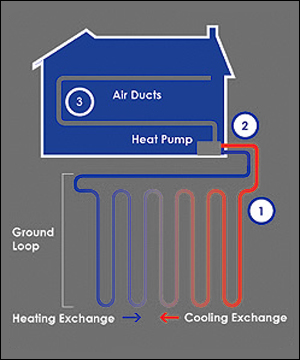Often we are asked the question “how does geothermal energy work“?
The Earth’s core provides a steady stream of energy which can be harnessed for powering heating and cooling systems, as well as general energy lines through careful engineering. What is key about geothermal energy is that it’s location-independent: nearly every region in the world has an active source of soil-based heat emanating from the core, and providing an important source of extensive energy.
As the technology expands, a growing number of homes and businesses are turning to geothermal energy sources rather than relying upon the expensive energy from traditional grid lines. Rapid adoption in Europe, Asia and North America owes its growth to vast improvements in geothermal technology around the globe.
Physicists long recognized the potential of ground-source energy to help power and heat a variety of sources. Stemming from the inception of the basic energy transfer technology in the 1940s, many communities have been actively harnessing the power of geothermal energy to provide electricity, heating and cooling. Leading regions which rely on the technology include Sweden, China, Iceland and Western parts of the United States. While the exact implementation of geothermal grids varies, the underlying technology relies on a core set of scientific principles.
Geothermal energy is harnessed through a series of convention systems which transfer heat from the earth’s core into modern energy generators. During the winter months, the constant temperatures in the core provide a heat transfer that helps make for affordable, sustainable sources of natural home heating. The convention occurs through a refrigerant solution which is heated by the ground soil conditions and then returns to the surface where the energy is used to generate energy.
There are various structures used in the process, including a steam cycle which powers a turbine as well as a hybrid system in which the heat is used to warm a secondary liquid that, in turn, provides a source of energy. Depending on the temperature of the soil, the systems may rely upon a heat exchange transfer system.
Large-scale systems that rely upon underground heat to produce steam energy can be found in California and Iceland. In California, there are dozens of geothermal plants producing over 1 Gigawatt of energy. Certain remote parts of Iceland rely almost entirely upon the technology for municipal and residential energy supplies, since importation and extensive grid construction is cost prohibitive. Iceland’s systems rely upon naturally occurring heat in dry rock, springs and steam reservoirs underneath the ground, further enhancing the energy transfer efficiency of the systems in question.
Most residential and commercial applications rely upon ground source heat pumps which connect directly to a building’s heating or cooling system. These technologies transfer energy from the underground heat which is conducted through a refrigerant, resulting in energy transfer that can provide an affordable source of energy regulation throughout the year. As a result, many home owners and commercial property managers supplement their energy systems with grounds source geothermal heat for environmental and financial advantages over the long run. Improving technology has enabled a wide variety of home owners to benefit from the systems as efficiency improves and costs decline.
Hopefully this information has helped answer the question ‘how does geothermal energy work‘, giving you a better understanding of the functionality, why it is better for the environment, and financial benefits. For more information please contact us today!
If you have any questions in regards to how does geothermal energy work, Contact us today.
You can also learn more information by visiting Georgia Air Contractors Geothermal page.

